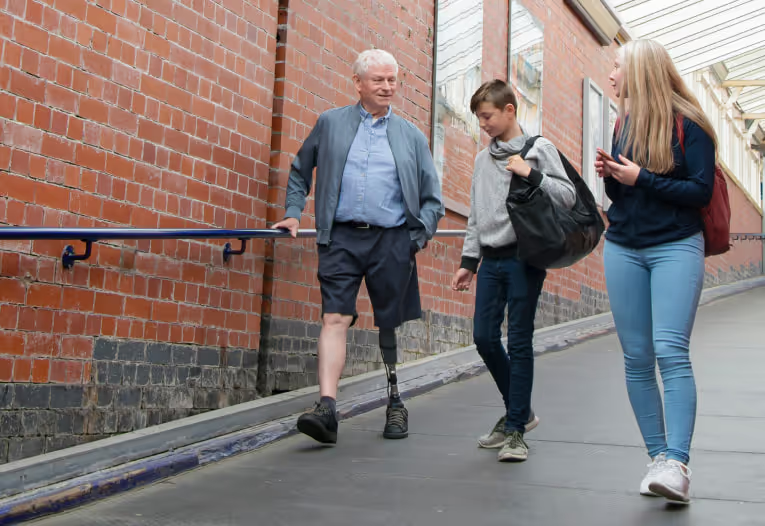Ankle Foot Orthotics (AFOs) Solutions in New Mexico
The foot and ankle play a pivotal role in providing stability and balance. If you or a loved one has experienced limb loss, you might have explored a transtibial amputation. Even though amputation is life-altering, you’ll get no better support in the Albuquerque, Las Cruces, and El Paso, NM area than our team at Prime Care Prosthetics & Orthotics.
%20(1).avif)
What Is AFO (Ankle Foot Orthosis)?
Those who need ankle foot orthoses or AFO braces are helping correct lower limb issues. These devices are helpful in providing support to the limb, improving the overall alignment while helping to reduce pain.
%202.0%20(1).avif)
Each custom-fabricated AFO is created to suit the specific needs of the patient, using a cast or a scan to ensure accuracy. They’re modified either by hand or through Computer Aided Design (CAD) technology to maximize both comfort and fit. Rest assured that the materials that we use are only of the highest quality. There are also pre-fabricated solutions that come in standard sizes for a more affordable and timely alternative.
How Long Does a Patient Wear a Custom AFO Brace?
For many patients the need to use an AFO device is ongoing. In some cases, such as in trauma cases, an AFO may only be used for the short term. The specific type of AFO or AFO knee brace that’s required for each patient could also change alongside their situation.
For example, if muscle strength and coordination improve after a stroke or a spinal cord injury, the AFO design could change. In some cases, the usage may stop altogether. We always strive to support our patients without overprescribing them.
Types of AFOs - Ankle-Foot Orthoses
There are different AFO brace types and varying AFO designs. Each orthotic brace encompasses the ankle and foot to help control the movement and position of the ankle. Here are only some of the designs that are available for an ankle foot orthotic device.
.avif)


.webp)
Schedule a Consultation with PrimeCare for Your Ankle-Foot Orthosis
To learn more about different AFO ankle foot orthosis options or to determine if you’re a good candidate, reach out to us today!

Which Conditions Require a Custom Orthosis for The Ankle & Foot?

- Nerve damage
- ALS
- Stroke
- Muscular dystrophy
- Partial foot amputation
- Charcot Marie Tooth (CMT)
- Cerebral Palsy (CP)
- Multiple Sclerosis (MS)
- Idiopathic toe walking
- Spinal cord injury
- Foot drop
- Trauma
- Lower limb weakness
- Ankle osteoarthritis
- Spina Bifida
- Muscle spasticity of the lower limbs
- Plantarflexion weakness
- Severe tibialis posterior dysfunction
- Plantar flexion contractures
- Dorsiflexion weakness causing foot drop
If you are wondering whether or not you could benefit from one of these devices, please reach out to our team to learn more.
Our Process
%20(1).avif)
- Step 1: Initial Evaluation
During the initial evaluation, we will get to know you and your situation, understanding your symptoms and pain points. This allows us to provide tailored recommendations.
- Step 2: Measurements
Once we’ve determined that you’re a good candidate for an AFO device, we will take your measurements to produce a custom solution for you.
- Step 3: Orthotics Fabrication
We’ll then take your measurements and move forward with fabricating your orthotic device. We will communicate with you to make sure you’re aware of the timeline, and we’re always happy to answer your questions.
- Step 4: Orthosis Delivery
We will let you know immediately when we receive your AFO device. The next appointment will consist of delivering your device and making sure you feel comfortable wearing it.
Why Choose PrimeCare for Ankle-Foot Orthosis?

Personalized Support

Latest Technologies

Experienced Team
Insurance and Financing
Contact Local AFO Provider in New Mexico
PrimeCare is located in Las Cruces but helps patients from Ciudad Juarez, El Paso, Albuquerque and surrounding areas.
Mon-Fri: 9:00am-5:00pm
Sat-Sun: Closed
FAQ
What types of shoes are compatible with AFOs?
There are plenty of shoe options for those who wear custom AFO braces. Generally speaking, shoes with shoelaces or shoes that can be adjusted in terms of tightness are the best. They allow for the foot to slip inside and the shoe to be adjusted around the AFO device.
How often do pediatrics require a new AFO and fitting?
As your child grows, he or she will need to seek a new or adjusted AFO device. Some pediatric patients need a new device every 6 months or so with this frequency lessening as the foot grows into its final adult size.
What socks should I wear with my AFO? Does it matter what material?
It’s important to note that your AFO should be worn with a smooth and long sock underneath it to act as a barrier between the orthosis and your skin. The sock prevents the device from causing skin problems. The sock that you wear over your device is usually knee-high.

.svg)
.svg)



.avif)
.avif)
.avif)